

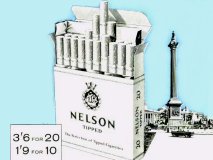
 |

|
 |
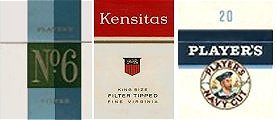 |
By
1949 cigarettes were a common, everyday item with an estimated 81% of men
and 39% of women smoking. The estimated daily consumption of manufactured
cigarettes per smoker:
|
   |
 |
| Advertising Sound files: Consulate Cigarettes 1967 Du Maurier Super Kings 1967 Players No.6 Cigarettes 1965 Kent Cigarettes 1960s With the introduction of ITV commercial television in 1955, cigarette companies soon began to advertise on TV. At that time there was no real established evidence that smoking caused health issues, which led to some curious and often misleading claims about the 'benefits' of smoking, even to the point where doctors were used in adverts to promote company products. In the United States, cigarette brands frequently sponsored television shows in the 1950s and 1960s. Concerns started to be raised about the health aspects of smoking and more research was being being carried out. A report in a British Medical Journal of 1950 had already suggested a link between smoking and lung cancer and, with ongoing further research, the Royal College of Physicians had enough evidence by 1962 to start calling for stricter laws on cigarette sales and a ban on advertising. On 7th March 1962 the RCP held its first ever press conference to launch the report on 'Smoking and Health'. |
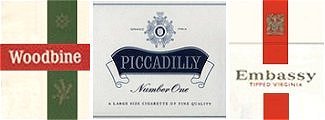 |
| The
authority has now laid down the following five rules governing advertisements
to be banned: 1. Advertisements that greatly over-emphasise the pleasure to be gained from cigarettes 2. Those featuring the conventional heroes of the young 3. Appealing to pride or general manliness 4. Using a fashionable social setting to support the impression that cigarette smoking is a 'go-ahead habit' or an essential part of the pleasure and excitement of modern living 5. Advertisements that strikingly present romantic situations and young people in love in such a way as to seem to link the pleasures of such situations with the pleasures of smoking". The tobacco companies responded by starting to label their products as 'mild', 'filtered' and 'calming' to allay consumer concerns, but the Royal College were not to be denied and, starting 1st August 1965, Harold Wilson's Labour government imposed a ban on cigarette advertising on UK television. |
   |
 |
This was by no means a total ban on tobacco advertising as other media,
such as radio, was still allowed and adverts for loose tobacco and cigars
continued to be allowed on the screen until 1991. In fact, the series of
adverts proclaiming 'Happiness is a cigar called Hamlet' remains one of
the best-remembered British television ads of all time. There was also a
myriad of other promotional items produced with brand name advertising,
such as playing cards. Following the television ban, the cigarette companies had plenty of cash to pursue other advertising directions, and one of the best of these was a 'way round' the direct TV advertising ban by sponsorship of sporting events and teams that were seen by millions of people worldwide. In 1968 Colin Chapman's Formula 1 'Team Lotus' became the first F1 team to overtly accept tobacco sponsorship and their Lotus 49 cars were painted in the colours of the 'Gold Leaf' cigarette brand. The incorporation of the sponsor's name and the complete branding of the racing cars in a commercial livery was the first example in Formula 1 of a practice that became known as 'brandstanding'. |
 |
It
was quite a while until legislation was able to catch up with the issue
of advertising in sport due to the multi-national nature of many of the
events, but The Tobacco Advertising and Promotion Act eventually banned
tobacco advertising in the print media and on billboards as of the 14th
February 2003. Direct mail and other kinds of promotions were also banned from this date and advertising around sport (other than global events) came into force on the 31st July 2003. In the case of Formula One motor racing, with its contractual commitments and the constant need for huge investment, the sport was allowed to continue to use tobacco advertising until July 2005. |
   |
 |
W.D.
& H.O. Wills The company was founded in 1786 as Wills, Watkins & Co. by Henry Overton Wills, and his partner, in Castle Street, Bristol. In 1789 it became 'Wills & Co.' and, from 1791 to 1793, was known as Lilly, Wills & Co when it merged with the company Peter Lilly, who owned a snuff mill. From 1793 to 1803 it was called Lilly and Wills. In 1826 two sons, William Day Wills and Henry Overton Wills took over the running of the company and changed the name to W.D. & H.O. Wills. Their first own brand was 'Bristol', actually made in their London factory, and lasted from 1871 to 1974. In 1874 'Three Castles' was introduced, followed by 'Gold Flake' in 1878 and 'Woodbine' in 1898. 'Embassy' was originally launched in 1914, being re-launched in 1962 with cigarette coupons. The company also produced cigar brands 'Castella' and 'Wills Whiffs' and 10 blends of loose tobacco including 'Golden Virginia' for hand rolling. The company possessed factories and offices in Swindon, Newcastle, Dublin, Edinburgh and Bristol, the latter being the largest cigarette factory in Europe when it was opened in 1974. The Newcastle factory closed in 1986. In 1901 Sir William Henry Wills was one of the founders of Imperial Tobacco when W.D. & H.O. Wills merged with seven other British tobacco companies and remains one of the biggest tobacco companies in the world. |
| Imperial
Tobacco By March 1960 Imperial was marketing 57 brands of cigarette and 183 varieties of tobacco as well as other tobacco-related products but was already starting diversification away from its prime focus on tobacco, moving towards the food, drink and leisure industries. This began with the acquisition of Golden Wonder crisps, a fairly small Edinburgh-based business which, by the end of the 1960s, it had turned into a leading brand in a multi-million pound market. Mardon Packaging International, a joint venture between Imperial and British American Tobacco was formed to market a wide variety of items including packaging, printing, plastic bottles and paper cups. Imperial acquired the Creators Group in 1964 and moved into industrial and domestic plastics. In 1967 it acquired the HP Sauce Group and its subsidiaries, which included Lea & Perrins. The National Canning Company (Smedley's) took the company into the frozen and tinned food market, further increased in 1969 with the acquisition of another frozen food operation, the Ross Group. In the same year Imperial changed its name to Imperial Tobacco Group Limited. Further acquisitions followed with Plastic Coatings / United Moulders in 1971 and Courage in 1972, including its 8 breweries, 6 bottling stores, 6,000 pubs, 38 hotels and nearly 700 off-licences. The company's name was changed again in 1973, becoming Imperial Group Limited, with Imperial Tobacco Limited being placed separately purely to manage its tobacco interests. The company launched the 'Strand' brand (3s.2d for 20) in 1959 but it only lasted a year due to the negative social aspect of the well-known, almost iconic tag-line and advert 'You're never alone with a Strand'. The TV campaign featured a lonely, rain-coated man in a dark, wet, deserted London street smoking a Strand cigarette. The background music was 'The Lonely Man Theme'. This, and a huge multimedia campaign, raised public awareness of the brand to more than 90% within weeks, but it seemed, ultimately, that people did not want to associate with the idea of being 'lonely' and the sales suffered as a result and it is a bit of a curiosity as to why the advert should be so well-remembered. In 1988 Imperial Tobacco withdrew the Wills brand in the United Kingdom (except for the Woodbine and Capstan Full Strength brands, which still carry the name). |
 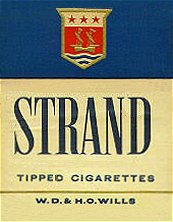 |
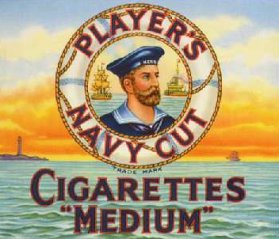 |
John
Player & Sons John Player, who was born in Saffron Walden, Essex, in 1839 started his career in tobacco by purchasing a shop on Beastmarket Hill, Nottingham, that sold fertiliser and seeds. He expanded the business, selling loose tobacco to farmers and agricultural workers and soon found that was more lucrative than his original stock. By 1871 he was registered as a tobacconist and, in 1877, bought his own tobacco factory in Broadmarsh, Nottingham, a small concern that had been owned by William Wright, and registered the first trademark of his company. Player's were one of the first UK tobacco companies to include picture cards in their cigarette packets, generally in sets of 50. They issued more than 200 sets including 'Castles and Abbeys' (1893), 'Footballers' (1926), 'Civil Aircraft' (1935) and 'Motor Cars' (1936). The 1960s were a significant decade for Player's, with 1960 celebrating the diamond jubilee of Navy Cut and the 'No.6' brand being launched in 1966 containing his cigarette coupons. The company also sponsored an influential series of celebrity lectures at the National Film Theatre between 1968 and 1973 where well over 100 international film stars took the stage to introduce screenings and discuss their career. From 1969 to 1987 John Player sponsored the John Player Sunday League for English county cricket clubs as well as their well-known sponsorship of the Lotus Formula One team and Norton motorcycle racing team. Although other cigarette companies had released brands with coupons, Player's provided a gift catalogue listing the items that coupons could be exchanged for and created a promotional team known as 'Player's Girls' who handed out samples and made sales at exhibitions and social events. Special prize-giving ceremonies were arranged for people when they claimed the gift they had saved coupons for, further enhancing Player's reputation for customer service and satisfaction. By the end of the decade the Player's company held 34% of the UK cigarette and tobacco market. |
  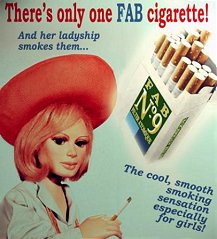 |
|
Benson & Hedges / Gallaher Benson and Hedges were acquired by Gallaher in 1953. Gallaher not only acquired an already-prestigious brand name but also the capability of launching new brands into the UK market which would, from the 1960s, include 'Benson and Hedges Special Filter' and 'Silk Cut'. To address increasing demand for their popular 'Senior Service' cigarettes, and other brands, had prompted them to add to their existing production facility at Middleton, near Oldham, purchasing a second factory in 1959 at Hyde, Greater Manchester. In 1962 the company expanded further by acquiring the manufacturers of Kensitas, J. Wix & Son, from the American Tobacco Company by offering a 13 per cent share holding in Gallaher. During 1968 Gallaher fought off an attempt by American manufacturers, Philip Morris, to acquire a 50% holding in the business before accepting a better bid from ATC and becoming a wholly-owned subsidiary. ATC changed its name to American Brands Inc. in 1975 and, later, to Fortune Brands. Gallaher became independent again in 1997 when it was de-merged and listed separately on the New York and London Exchanges. |
 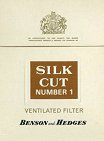 |
  |
 |
Sixties City does not condone
or advise smoking or the use of tobacco products. Smoking is harmful to
your health and may cause fatal diseases
|
|
|
All
Original Material Copyright SixtiesCity
Other individual owner copyrights may apply to Photographic Images |